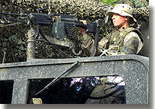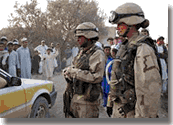|
 are acknowledged, affirmed and commemorated.
|
Posted on 02/15/2003 12:00:57 AM PST by SAMWolf
|
 are acknowledged, affirmed and commemorated.
|

|
|
 Today the FReeper Foxhole invites you to visit the home of the skeptical, irrascible, doubting, iconoclastic Captain Critical, aka Captain Barb, whose pontificating will try to amuse, bemuse, irritate and generally annoy anyone bold enough to stay long enough to read the random ramblings of a self appointed distaff critic of anything and everything from new age to old age, from god to goddesses, and from here to infinity. And who will continue to remind you that women are veterans too! Civil War Women The War of 1812 and Spanish American War World War One Women World War Two Women  They Also Served -WASP, Spec. Svcs. Post WWII and Korea Women Women in Vietnam Women in Grenada and Panama Women in Desert Storm  Somalia, Bosnia and More Operation Desert Fox The Military Academies Women in the National Guard They Gave Their Lives  Women Prisoners of War Famous Women in Arlington National Cemetery Gender Integrated Training Women Who Were Spies Military Women Pilots  Myths, Fallacies and Urban Legends 21st Century Combat  Click on the graphic to visit Captain Barbara A. Wilson's, USAF (Ret) Site If you want to know anything about women in the Military, this site is the best I've ever seen
|
I agree with you. I also think that there service is just as important as any mans.

Today's classic warship, USS Maine (ACR-1)
Maine class armored cruiser
Displacement. 6,682 t.
Lenght. 319'
Beam. 57'
Draft. 21' 6"
Complement. 374
Speed. 17 k.
Armament. 4 10", 6 6", 7 6-pdrs., 8 1-pdrs., 4 14" tt.
The USS Maine was designed and laid down as an armored cruiser. Her construction was delayed by a fire in the drafting room of the New York Navy Yard and also by the late delivery of her armor. By the time she was ready, the concept of the armored cruiser had moved beyond her. Too slow and heavily armored to be considered a cruiser, she was later redisignated a second-class battleship during her lenghty construction.
The USS Maine (ACR-1), was laid down at New York Navy Yard 17 October 1888; launched 18 November 1889, sponsored by Miss Alice Tracy Wilmerding, granddaughter of Secretary of the Navy Benjamin Tracy; and commissi oned 17 September 1895, Capt. Arent S. Crowninshield in command.
Maine departed New York Navy Yard 5 November 1895 for Newport, R.I., via Gardiner's Bay, N.Y., to fit out 16 to 23 November, and then proceeded on the 25th to Portland, Maine, to visit her namesake. The battlewagon then put to sea on the 29th on trials and inspection, being assigned to the North Atlantic Squadron 16 December, and sailing via Newport to Tompkinsville, N.Y., arriving 23 December. The ship sailed the next day for Fort Monroe, Va., arriving on Christmas Day. She operated out of that place and Newport News through June 1896 and then on the 4th sailed for Key West on a 2-month training cruise, returning to Norfolk 3 August. Maine continued extensive east coast operations until late 1897. Then the ship prepared for a voyage to Havana, Cuba, to show the flag and to protect American citizens in event of violence in the Spanish struggle with the revolutionary forces in Cuba.
On 11 December Maine stood out of Hampton Roads bound for Key West, arriving on the 15th. She was joined there by ships of the North Atlantic Squadron on maneuvers, then left Key West 24 January 1898 for Havana.
Arriving 25 January, Maine anchored in the center of the port, remained on vigilant watch, allowed no liberty, and took extra precautions against sabotage. Shortly after 2140, 15 February, the battleship was torn apart by a tremendous explosion that shattered the entire forward part of the ship. Out of 350 officers and men on board that night (4 officers were ashore), 252 were dead or missing. Eight more were to die in Havana hospitals during the next few days. The survivors of the disaster were taken on board Ward Line steamer City of Washington and Spanish cruiser Alfonso XII. The Spanish officials at Havana showed every attention to the survivors of the disaster and great respect for those killed. The court of inquiry convened in March was unable to obtain evidence associating the destruction of the battleship with any person or persons, but public opinion in the United States was so inflamed that the Maine disaster led eventually to the declaration of war on Spain 21 April.
On 5 August 1910, Congress authorized the raising of Maine and directed Army engineers to supervise the work. A second board of inquiry appointed to inspect the wreck after it was raised reported that injuries to the ship's bottom were caused by an external explosion of low magnitude that set off the forward magazine, completing destruction of the ship.
Technical experts at the time of both investigations disagreed with the findings, believing that spontaneous combustion of coal in the bunker adjacent to the reserve six-inch magazine was the most likely cause of the explosion on board the ship. In 1976, Admiral Hyman G. Rickover published his book, How the Battleship Maine Was Destroyed. The admiral became interested in the disaster and wondered if the application of modern scientific knowledge could determine the cause. He called on two experts on explosions and their effects on ship hulls.
Using documentation gathered from the two official inquiries, as well as information on the construction and ammunition of Maine, the experts concluded that the damage caused to the ship was inconsistent with the external explosion of a mine. The most likely cause, they speculated, was spontaneous combustion of coal in the bunker next to the magazine.
Some historians have disputed the findings in Rickover's book, maintaining that failure to detect spontaneous combustion in the coal bunker was highly unlikely. Yet evidence of a mine remains thin and such theories are based primarily on conjecture. Despite the best efforts of experts and historians in investigating this complex and technical subject, a definitive explanation for the destruction of Maine remains one of the continuing enigmas of American history.
Maine's hulk was finally floated 2 February 1912 and towed out to sea where it was sunk in deep water in the Gulf of Mexico with appropriate ceremony and military honors 16 March.


Valin! OMG!! Let's try to keep the history post rated 'PG' please!
Disclaimer: Opinions posted on Free Republic are those of the individual posters and do not necessarily represent the opinion of Free Republic or its management. All materials posted herein are protected by copyright law and the exemption for fair use of copyrighted works.